Housing Needs of Old People
VerifiedAdded on 2023/04/21
|16
|4025
|167
AI Summary
This article discusses the housing needs of older people and explores strategies for developing safer and quality housing for them. It highlights the impact of housing on their physical, emotional, and mental health. The article also addresses the hazardous design of many houses and the physical environmental barriers that affect the accessibility and safety of older individuals. Additionally, it discusses the importance of optimal person-environment fit and the role of home modifications in promoting independence and well-being. The article concludes by discussing factors affecting the housing status of older people and the challenges of downsizing.
Contribute Materials
Your contribution can guide someone’s learning journey. Share your
documents today.

Running head: HOSUNING NEEDS OF OLD PEOPLE
HOSUNING NEEDS OF OLD PEOPLE
Name of the student:
Name of the university:
Author note:
HOSUNING NEEDS OF OLD PEOPLE
Name of the student:
Name of the university:
Author note:
Secure Best Marks with AI Grader
Need help grading? Try our AI Grader for instant feedback on your assignments.
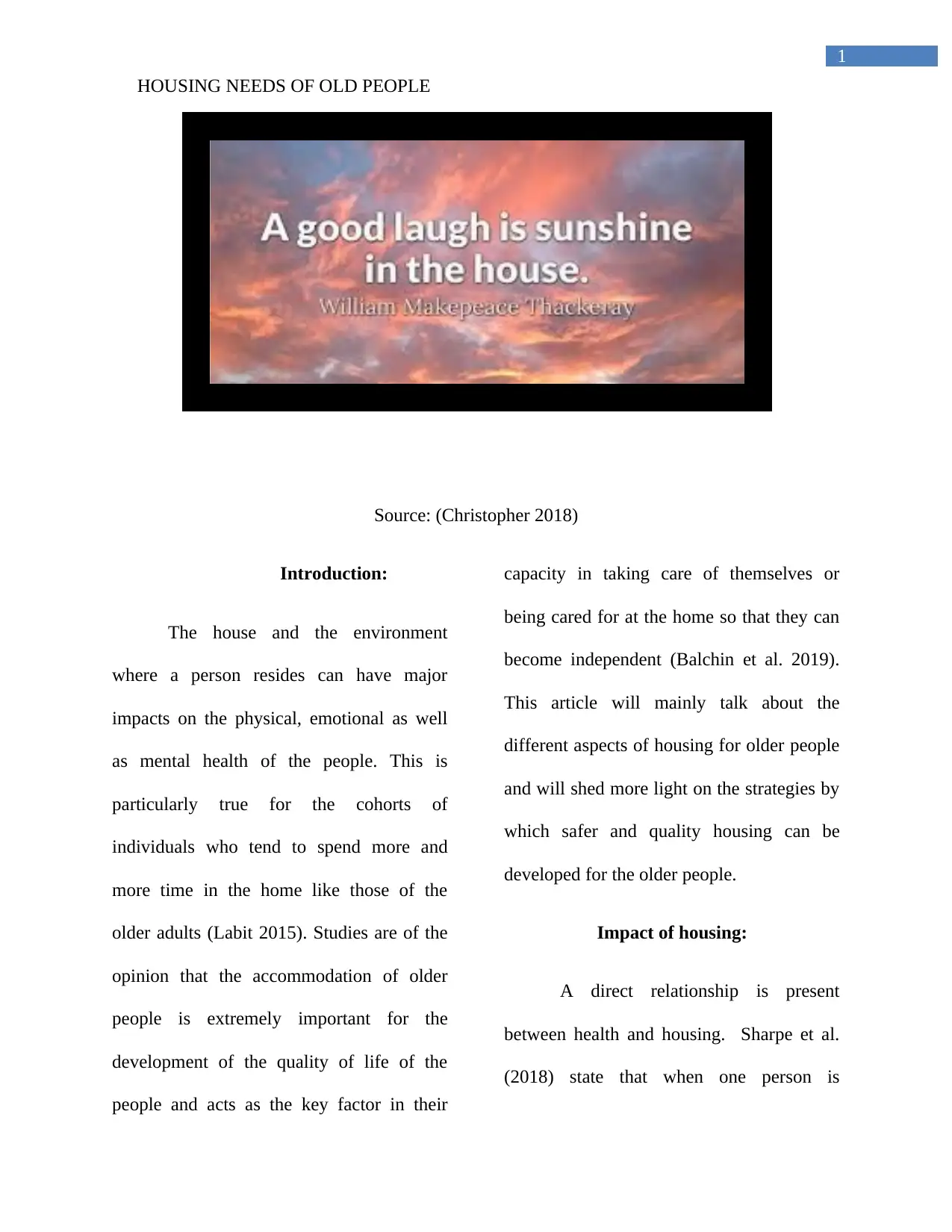
1
HOUSING NEEDS OF OLD PEOPLE
Source: (Christopher 2018)
Introduction:
The house and the environment
where a person resides can have major
impacts on the physical, emotional as well
as mental health of the people. This is
particularly true for the cohorts of
individuals who tend to spend more and
more time in the home like those of the
older adults (Labit 2015). Studies are of the
opinion that the accommodation of older
people is extremely important for the
development of the quality of life of the
people and acts as the key factor in their
capacity in taking care of themselves or
being cared for at the home so that they can
become independent (Balchin et al. 2019).
This article will mainly talk about the
different aspects of housing for older people
and will shed more light on the strategies by
which safer and quality housing can be
developed for the older people.
Impact of housing:
A direct relationship is present
between health and housing. Sharpe et al.
(2018) state that when one person is
HOUSING NEEDS OF OLD PEOPLE
Source: (Christopher 2018)
Introduction:
The house and the environment
where a person resides can have major
impacts on the physical, emotional as well
as mental health of the people. This is
particularly true for the cohorts of
individuals who tend to spend more and
more time in the home like those of the
older adults (Labit 2015). Studies are of the
opinion that the accommodation of older
people is extremely important for the
development of the quality of life of the
people and acts as the key factor in their
capacity in taking care of themselves or
being cared for at the home so that they can
become independent (Balchin et al. 2019).
This article will mainly talk about the
different aspects of housing for older people
and will shed more light on the strategies by
which safer and quality housing can be
developed for the older people.
Impact of housing:
A direct relationship is present
between health and housing. Sharpe et al.
(2018) state that when one person is
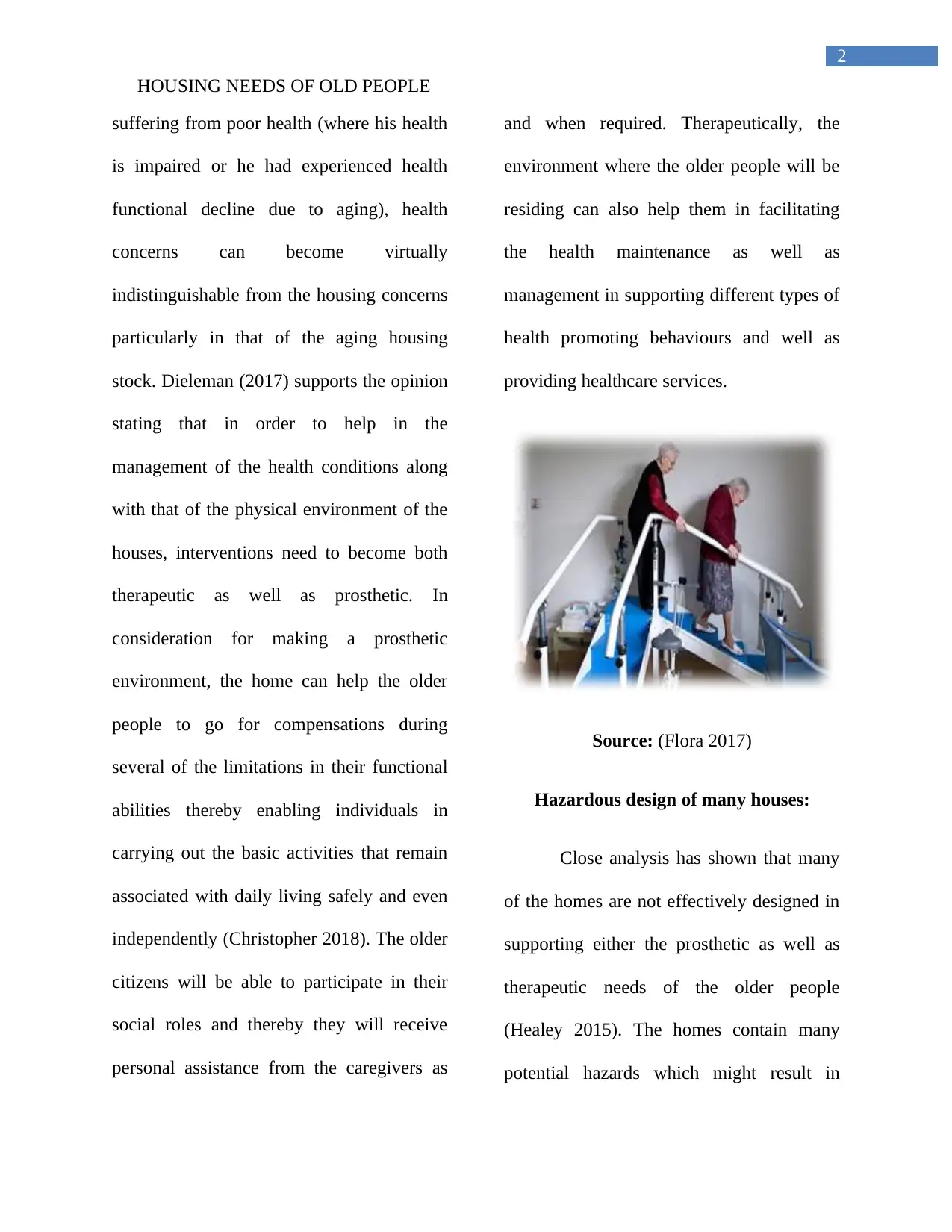
2
HOUSING NEEDS OF OLD PEOPLE
suffering from poor health (where his health
is impaired or he had experienced health
functional decline due to aging), health
concerns can become virtually
indistinguishable from the housing concerns
particularly in that of the aging housing
stock. Dieleman (2017) supports the opinion
stating that in order to help in the
management of the health conditions along
with that of the physical environment of the
houses, interventions need to become both
therapeutic as well as prosthetic. In
consideration for making a prosthetic
environment, the home can help the older
people to go for compensations during
several of the limitations in their functional
abilities thereby enabling individuals in
carrying out the basic activities that remain
associated with daily living safely and even
independently (Christopher 2018). The older
citizens will be able to participate in their
social roles and thereby they will receive
personal assistance from the caregivers as
and when required. Therapeutically, the
environment where the older people will be
residing can also help them in facilitating
the health maintenance as well as
management in supporting different types of
health promoting behaviours and well as
providing healthcare services.
Source: (Flora 2017)
Hazardous design of many houses:
Close analysis has shown that many
of the homes are not effectively designed in
supporting either the prosthetic as well as
therapeutic needs of the older people
(Healey 2015). The homes contain many
potential hazards which might result in
HOUSING NEEDS OF OLD PEOPLE
suffering from poor health (where his health
is impaired or he had experienced health
functional decline due to aging), health
concerns can become virtually
indistinguishable from the housing concerns
particularly in that of the aging housing
stock. Dieleman (2017) supports the opinion
stating that in order to help in the
management of the health conditions along
with that of the physical environment of the
houses, interventions need to become both
therapeutic as well as prosthetic. In
consideration for making a prosthetic
environment, the home can help the older
people to go for compensations during
several of the limitations in their functional
abilities thereby enabling individuals in
carrying out the basic activities that remain
associated with daily living safely and even
independently (Christopher 2018). The older
citizens will be able to participate in their
social roles and thereby they will receive
personal assistance from the caregivers as
and when required. Therapeutically, the
environment where the older people will be
residing can also help them in facilitating
the health maintenance as well as
management in supporting different types of
health promoting behaviours and well as
providing healthcare services.
Source: (Flora 2017)
Hazardous design of many houses:
Close analysis has shown that many
of the homes are not effectively designed in
supporting either the prosthetic as well as
therapeutic needs of the older people
(Healey 2015). The homes contain many
potential hazards which might result in
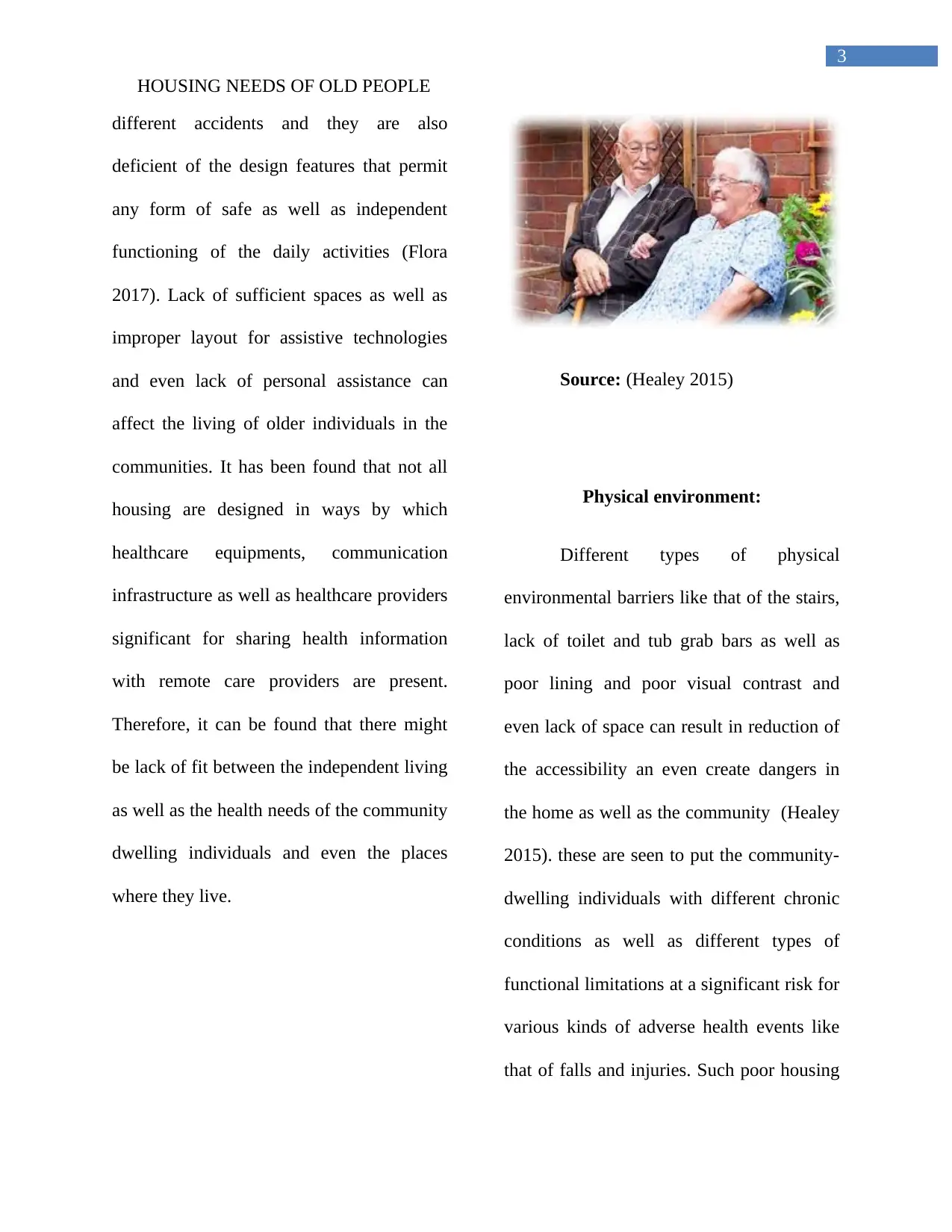
3
HOUSING NEEDS OF OLD PEOPLE
different accidents and they are also
deficient of the design features that permit
any form of safe as well as independent
functioning of the daily activities (Flora
2017). Lack of sufficient spaces as well as
improper layout for assistive technologies
and even lack of personal assistance can
affect the living of older individuals in the
communities. It has been found that not all
housing are designed in ways by which
healthcare equipments, communication
infrastructure as well as healthcare providers
significant for sharing health information
with remote care providers are present.
Therefore, it can be found that there might
be lack of fit between the independent living
as well as the health needs of the community
dwelling individuals and even the places
where they live.
Source: (Healey 2015)
Physical environment:
Different types of physical
environmental barriers like that of the stairs,
lack of toilet and tub grab bars as well as
poor lining and poor visual contrast and
even lack of space can result in reduction of
the accessibility an even create dangers in
the home as well as the community (Healey
2015). these are seen to put the community-
dwelling individuals with different chronic
conditions as well as different types of
functional limitations at a significant risk for
various kinds of adverse health events like
that of falls and injuries. Such poor housing
HOUSING NEEDS OF OLD PEOPLE
different accidents and they are also
deficient of the design features that permit
any form of safe as well as independent
functioning of the daily activities (Flora
2017). Lack of sufficient spaces as well as
improper layout for assistive technologies
and even lack of personal assistance can
affect the living of older individuals in the
communities. It has been found that not all
housing are designed in ways by which
healthcare equipments, communication
infrastructure as well as healthcare providers
significant for sharing health information
with remote care providers are present.
Therefore, it can be found that there might
be lack of fit between the independent living
as well as the health needs of the community
dwelling individuals and even the places
where they live.
Source: (Healey 2015)
Physical environment:
Different types of physical
environmental barriers like that of the stairs,
lack of toilet and tub grab bars as well as
poor lining and poor visual contrast and
even lack of space can result in reduction of
the accessibility an even create dangers in
the home as well as the community (Healey
2015). these are seen to put the community-
dwelling individuals with different chronic
conditions as well as different types of
functional limitations at a significant risk for
various kinds of adverse health events like
that of falls and injuries. Such poor housing
Secure Best Marks with AI Grader
Need help grading? Try our AI Grader for instant feedback on your assignments.
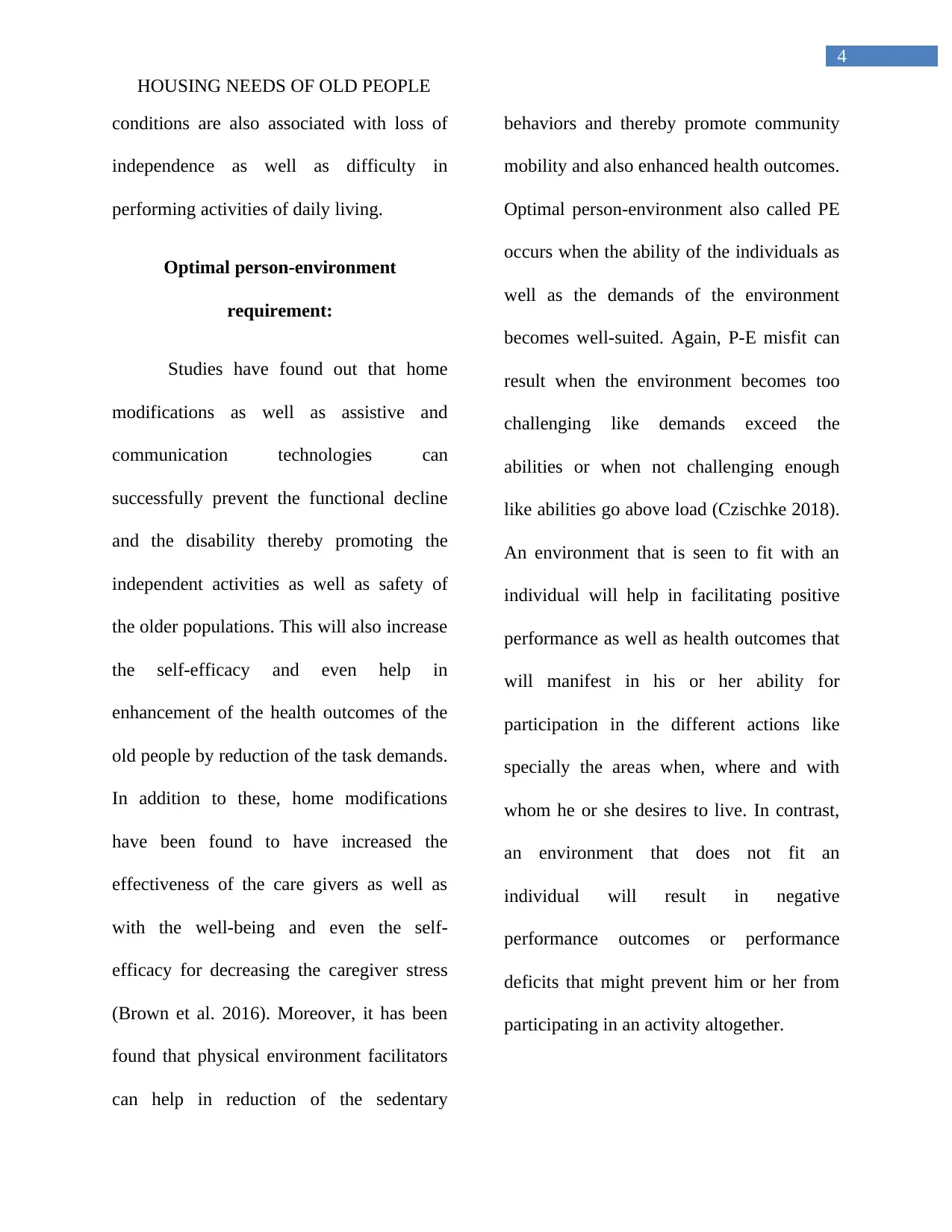
4
HOUSING NEEDS OF OLD PEOPLE
conditions are also associated with loss of
independence as well as difficulty in
performing activities of daily living.
Optimal person-environment
requirement:
Studies have found out that home
modifications as well as assistive and
communication technologies can
successfully prevent the functional decline
and the disability thereby promoting the
independent activities as well as safety of
the older populations. This will also increase
the self-efficacy and even help in
enhancement of the health outcomes of the
old people by reduction of the task demands.
In addition to these, home modifications
have been found to have increased the
effectiveness of the care givers as well as
with the well-being and even the self-
efficacy for decreasing the caregiver stress
(Brown et al. 2016). Moreover, it has been
found that physical environment facilitators
can help in reduction of the sedentary
behaviors and thereby promote community
mobility and also enhanced health outcomes.
Optimal person-environment also called PE
occurs when the ability of the individuals as
well as the demands of the environment
becomes well-suited. Again, P-E misfit can
result when the environment becomes too
challenging like demands exceed the
abilities or when not challenging enough
like abilities go above load (Czischke 2018).
An environment that is seen to fit with an
individual will help in facilitating positive
performance as well as health outcomes that
will manifest in his or her ability for
participation in the different actions like
specially the areas when, where and with
whom he or she desires to live. In contrast,
an environment that does not fit an
individual will result in negative
performance outcomes or performance
deficits that might prevent him or her from
participating in an activity altogether.
HOUSING NEEDS OF OLD PEOPLE
conditions are also associated with loss of
independence as well as difficulty in
performing activities of daily living.
Optimal person-environment
requirement:
Studies have found out that home
modifications as well as assistive and
communication technologies can
successfully prevent the functional decline
and the disability thereby promoting the
independent activities as well as safety of
the older populations. This will also increase
the self-efficacy and even help in
enhancement of the health outcomes of the
old people by reduction of the task demands.
In addition to these, home modifications
have been found to have increased the
effectiveness of the care givers as well as
with the well-being and even the self-
efficacy for decreasing the caregiver stress
(Brown et al. 2016). Moreover, it has been
found that physical environment facilitators
can help in reduction of the sedentary
behaviors and thereby promote community
mobility and also enhanced health outcomes.
Optimal person-environment also called PE
occurs when the ability of the individuals as
well as the demands of the environment
becomes well-suited. Again, P-E misfit can
result when the environment becomes too
challenging like demands exceed the
abilities or when not challenging enough
like abilities go above load (Czischke 2018).
An environment that is seen to fit with an
individual will help in facilitating positive
performance as well as health outcomes that
will manifest in his or her ability for
participation in the different actions like
specially the areas when, where and with
whom he or she desires to live. In contrast,
an environment that does not fit an
individual will result in negative
performance outcomes or performance
deficits that might prevent him or her from
participating in an activity altogether.
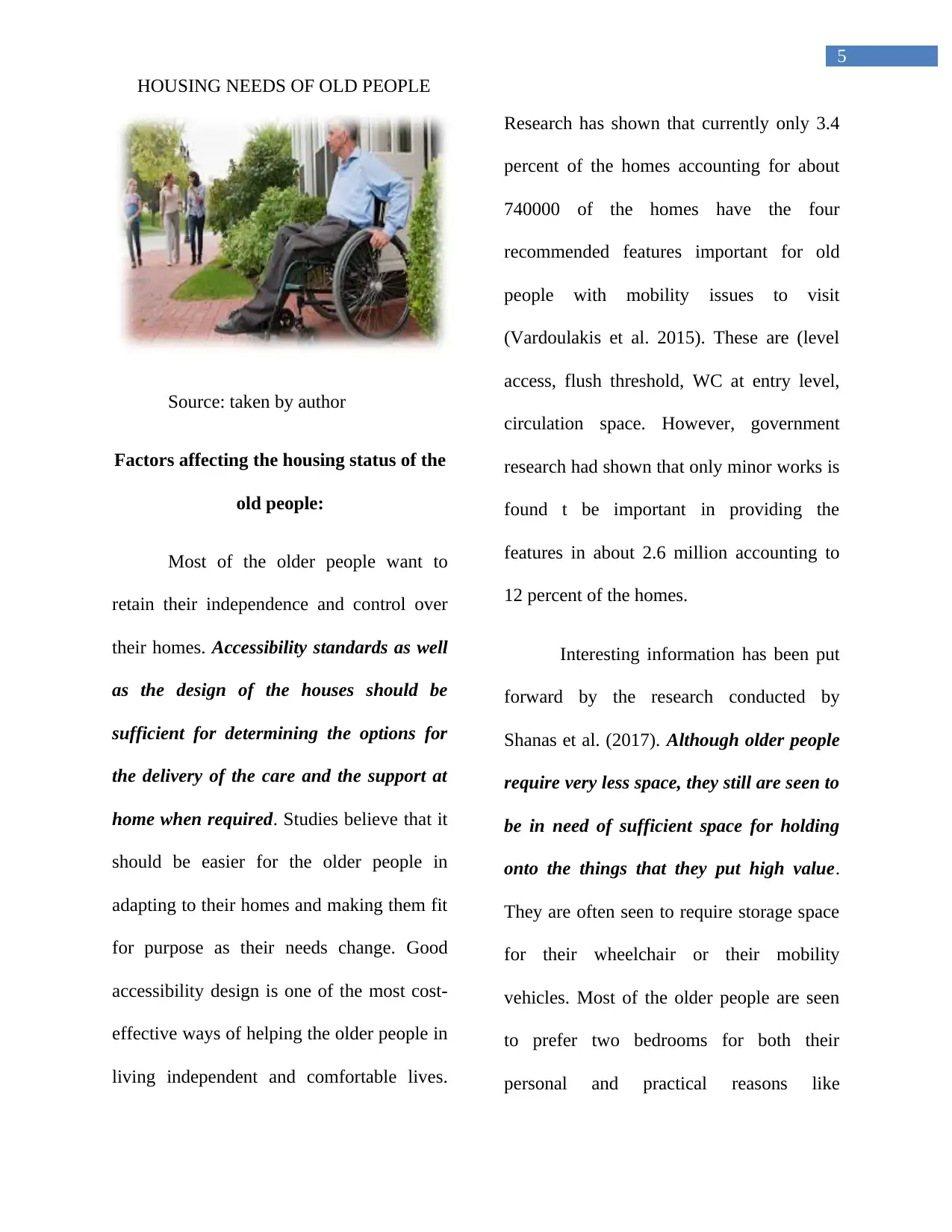
5
HOUSING NEEDS OF OLD PEOPLE
Source: taken by author
Factors affecting the housing status of the
old people:
Most of the older people want to
retain their independence and control over
their homes. Accessibility standards as well
as the design of the houses should be
sufficient for determining the options for
the delivery of the care and the support at
home when required. Studies believe that it
should be easier for the older people in
adapting to their homes and making them fit
for purpose as their needs change. Good
accessibility design is one of the most cost-
effective ways of helping the older people in
living independent and comfortable lives.
Research has shown that currently only 3.4
percent of the homes accounting for about
740000 of the homes have the four
recommended features important for old
people with mobility issues to visit
(Vardoulakis et al. 2015). These are (level
access, flush threshold, WC at entry level,
circulation space. However, government
research had shown that only minor works is
found t be important in providing the
features in about 2.6 million accounting to
12 percent of the homes.
Interesting information has been put
forward by the research conducted by
Shanas et al. (2017). Although older people
require very less space, they still are seen to
be in need of sufficient space for holding
onto the things that they put high value.
They are often seen to require storage space
for their wheelchair or their mobility
vehicles. Most of the older people are seen
to prefer two bedrooms for both their
personal and practical reasons like
HOUSING NEEDS OF OLD PEOPLE
Source: taken by author
Factors affecting the housing status of the
old people:
Most of the older people want to
retain their independence and control over
their homes. Accessibility standards as well
as the design of the houses should be
sufficient for determining the options for
the delivery of the care and the support at
home when required. Studies believe that it
should be easier for the older people in
adapting to their homes and making them fit
for purpose as their needs change. Good
accessibility design is one of the most cost-
effective ways of helping the older people in
living independent and comfortable lives.
Research has shown that currently only 3.4
percent of the homes accounting for about
740000 of the homes have the four
recommended features important for old
people with mobility issues to visit
(Vardoulakis et al. 2015). These are (level
access, flush threshold, WC at entry level,
circulation space. However, government
research had shown that only minor works is
found t be important in providing the
features in about 2.6 million accounting to
12 percent of the homes.
Interesting information has been put
forward by the research conducted by
Shanas et al. (2017). Although older people
require very less space, they still are seen to
be in need of sufficient space for holding
onto the things that they put high value.
They are often seen to require storage space
for their wheelchair or their mobility
vehicles. Most of the older people are seen
to prefer two bedrooms for both their
personal and practical reasons like
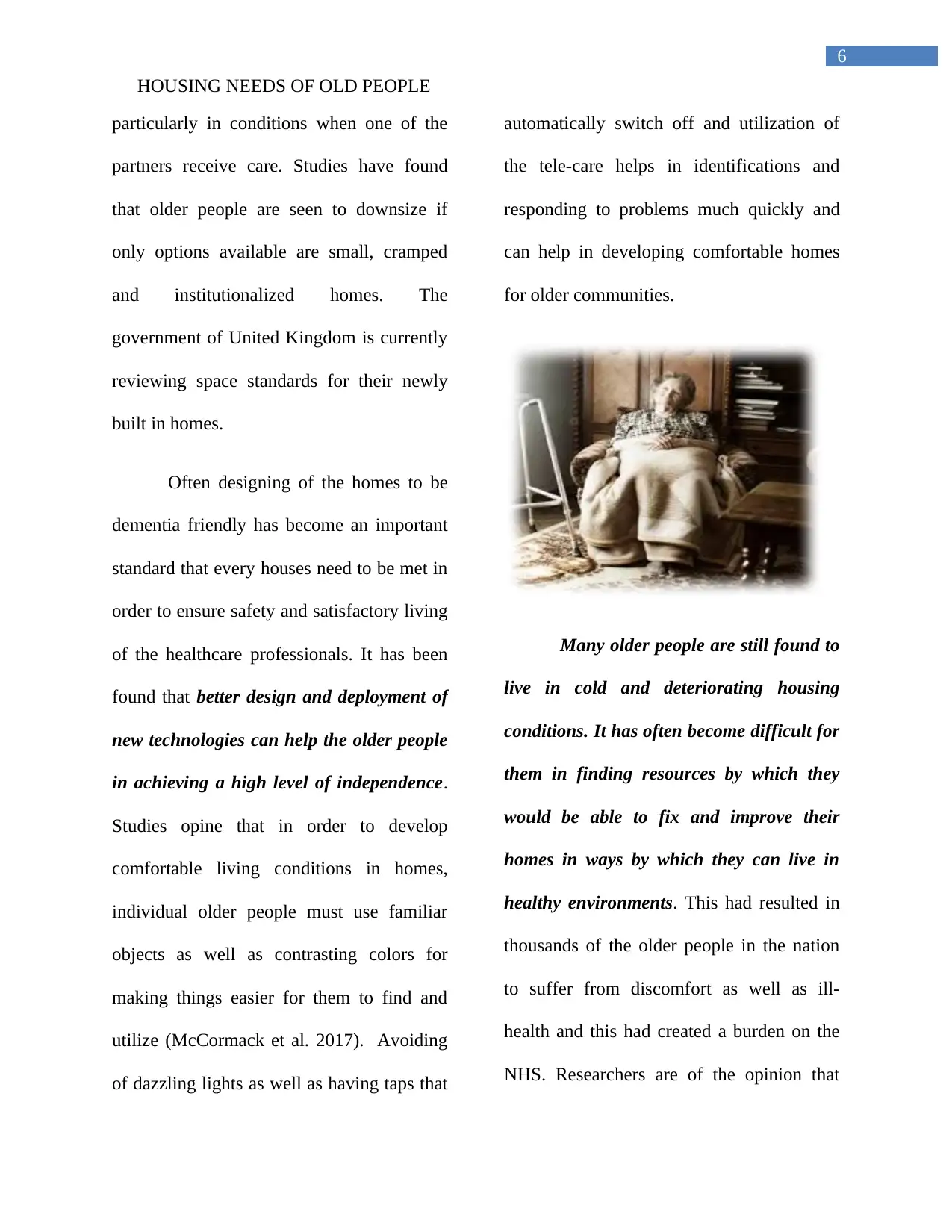
6
HOUSING NEEDS OF OLD PEOPLE
particularly in conditions when one of the
partners receive care. Studies have found
that older people are seen to downsize if
only options available are small, cramped
and institutionalized homes. The
government of United Kingdom is currently
reviewing space standards for their newly
built in homes.
Often designing of the homes to be
dementia friendly has become an important
standard that every houses need to be met in
order to ensure safety and satisfactory living
of the healthcare professionals. It has been
found that better design and deployment of
new technologies can help the older people
in achieving a high level of independence.
Studies opine that in order to develop
comfortable living conditions in homes,
individual older people must use familiar
objects as well as contrasting colors for
making things easier for them to find and
utilize (McCormack et al. 2017). Avoiding
of dazzling lights as well as having taps that
automatically switch off and utilization of
the tele-care helps in identifications and
responding to problems much quickly and
can help in developing comfortable homes
for older communities.
Many older people are still found to
live in cold and deteriorating housing
conditions. It has often become difficult for
them in finding resources by which they
would be able to fix and improve their
homes in ways by which they can live in
healthy environments. This had resulted in
thousands of the older people in the nation
to suffer from discomfort as well as ill-
health and this had created a burden on the
NHS. Researchers are of the opinion that
HOUSING NEEDS OF OLD PEOPLE
particularly in conditions when one of the
partners receive care. Studies have found
that older people are seen to downsize if
only options available are small, cramped
and institutionalized homes. The
government of United Kingdom is currently
reviewing space standards for their newly
built in homes.
Often designing of the homes to be
dementia friendly has become an important
standard that every houses need to be met in
order to ensure safety and satisfactory living
of the healthcare professionals. It has been
found that better design and deployment of
new technologies can help the older people
in achieving a high level of independence.
Studies opine that in order to develop
comfortable living conditions in homes,
individual older people must use familiar
objects as well as contrasting colors for
making things easier for them to find and
utilize (McCormack et al. 2017). Avoiding
of dazzling lights as well as having taps that
automatically switch off and utilization of
the tele-care helps in identifications and
responding to problems much quickly and
can help in developing comfortable homes
for older communities.
Many older people are still found to
live in cold and deteriorating housing
conditions. It has often become difficult for
them in finding resources by which they
would be able to fix and improve their
homes in ways by which they can live in
healthy environments. This had resulted in
thousands of the older people in the nation
to suffer from discomfort as well as ill-
health and this had created a burden on the
NHS. Researchers are of the opinion that
Paraphrase This Document
Need a fresh take? Get an instant paraphrase of this document with our AI Paraphraser
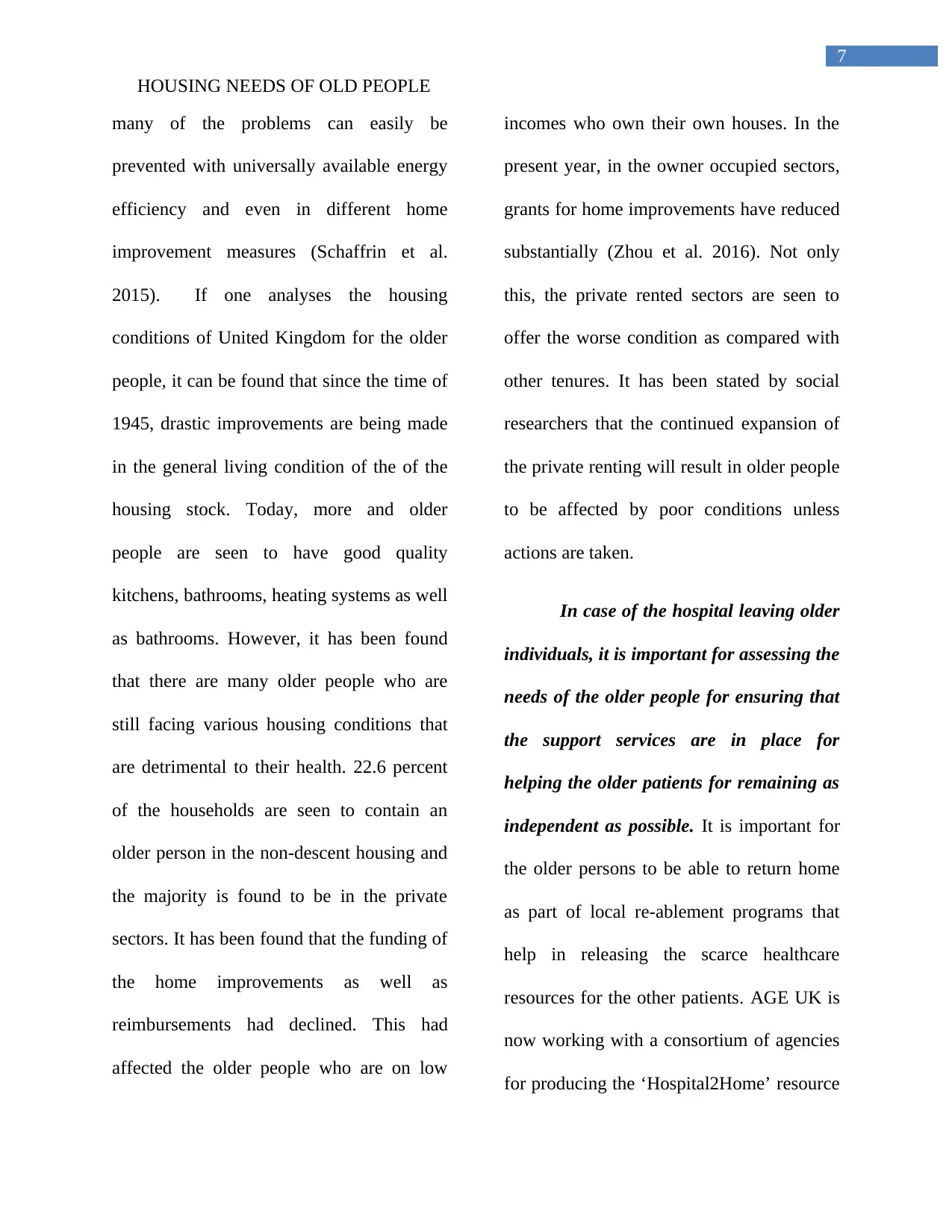
7
HOUSING NEEDS OF OLD PEOPLE
many of the problems can easily be
prevented with universally available energy
efficiency and even in different home
improvement measures (Schaffrin et al.
2015). If one analyses the housing
conditions of United Kingdom for the older
people, it can be found that since the time of
1945, drastic improvements are being made
in the general living condition of the of the
housing stock. Today, more and older
people are seen to have good quality
kitchens, bathrooms, heating systems as well
as bathrooms. However, it has been found
that there are many older people who are
still facing various housing conditions that
are detrimental to their health. 22.6 percent
of the households are seen to contain an
older person in the non-descent housing and
the majority is found to be in the private
sectors. It has been found that the funding of
the home improvements as well as
reimbursements had declined. This had
affected the older people who are on low
incomes who own their own houses. In the
present year, in the owner occupied sectors,
grants for home improvements have reduced
substantially (Zhou et al. 2016). Not only
this, the private rented sectors are seen to
offer the worse condition as compared with
other tenures. It has been stated by social
researchers that the continued expansion of
the private renting will result in older people
to be affected by poor conditions unless
actions are taken.
In case of the hospital leaving older
individuals, it is important for assessing the
needs of the older people for ensuring that
the support services are in place for
helping the older patients for remaining as
independent as possible. It is important for
the older persons to be able to return home
as part of local re-ablement programs that
help in releasing the scarce healthcare
resources for the other patients. AGE UK is
now working with a consortium of agencies
for producing the ‘Hospital2Home’ resource
HOUSING NEEDS OF OLD PEOPLE
many of the problems can easily be
prevented with universally available energy
efficiency and even in different home
improvement measures (Schaffrin et al.
2015). If one analyses the housing
conditions of United Kingdom for the older
people, it can be found that since the time of
1945, drastic improvements are being made
in the general living condition of the of the
housing stock. Today, more and older
people are seen to have good quality
kitchens, bathrooms, heating systems as well
as bathrooms. However, it has been found
that there are many older people who are
still facing various housing conditions that
are detrimental to their health. 22.6 percent
of the households are seen to contain an
older person in the non-descent housing and
the majority is found to be in the private
sectors. It has been found that the funding of
the home improvements as well as
reimbursements had declined. This had
affected the older people who are on low
incomes who own their own houses. In the
present year, in the owner occupied sectors,
grants for home improvements have reduced
substantially (Zhou et al. 2016). Not only
this, the private rented sectors are seen to
offer the worse condition as compared with
other tenures. It has been stated by social
researchers that the continued expansion of
the private renting will result in older people
to be affected by poor conditions unless
actions are taken.
In case of the hospital leaving older
individuals, it is important for assessing the
needs of the older people for ensuring that
the support services are in place for
helping the older patients for remaining as
independent as possible. It is important for
the older persons to be able to return home
as part of local re-ablement programs that
help in releasing the scarce healthcare
resources for the other patients. AGE UK is
now working with a consortium of agencies
for producing the ‘Hospital2Home’ resource
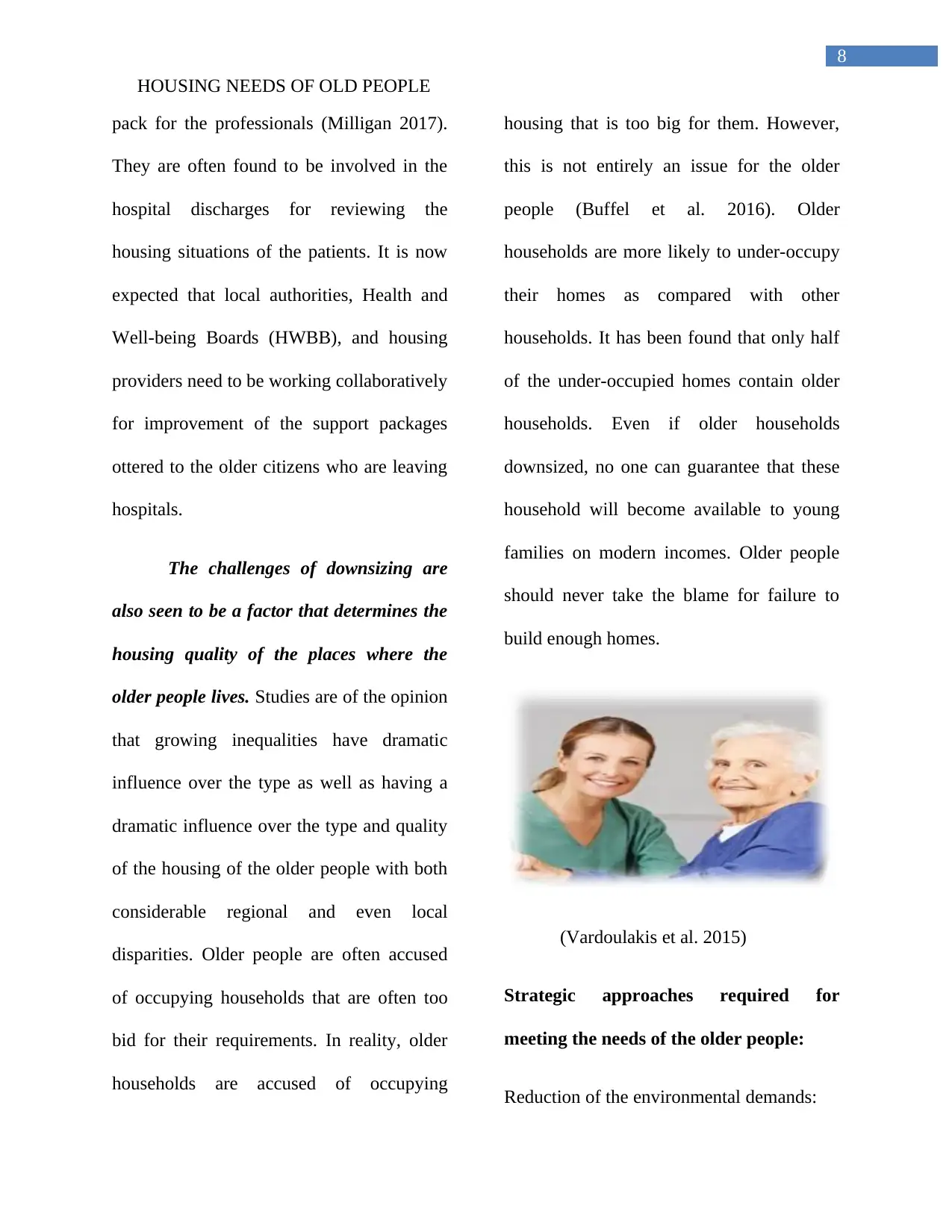
8
HOUSING NEEDS OF OLD PEOPLE
pack for the professionals (Milligan 2017).
They are often found to be involved in the
hospital discharges for reviewing the
housing situations of the patients. It is now
expected that local authorities, Health and
Well-being Boards (HWBB), and housing
providers need to be working collaboratively
for improvement of the support packages
ottered to the older citizens who are leaving
hospitals.
The challenges of downsizing are
also seen to be a factor that determines the
housing quality of the places where the
older people lives. Studies are of the opinion
that growing inequalities have dramatic
influence over the type as well as having a
dramatic influence over the type and quality
of the housing of the older people with both
considerable regional and even local
disparities. Older people are often accused
of occupying households that are often too
bid for their requirements. In reality, older
households are accused of occupying
housing that is too big for them. However,
this is not entirely an issue for the older
people (Buffel et al. 2016). Older
households are more likely to under-occupy
their homes as compared with other
households. It has been found that only half
of the under-occupied homes contain older
households. Even if older households
downsized, no one can guarantee that these
household will become available to young
families on modern incomes. Older people
should never take the blame for failure to
build enough homes.
(Vardoulakis et al. 2015)
Strategic approaches required for
meeting the needs of the older people:
Reduction of the environmental demands:
HOUSING NEEDS OF OLD PEOPLE
pack for the professionals (Milligan 2017).
They are often found to be involved in the
hospital discharges for reviewing the
housing situations of the patients. It is now
expected that local authorities, Health and
Well-being Boards (HWBB), and housing
providers need to be working collaboratively
for improvement of the support packages
ottered to the older citizens who are leaving
hospitals.
The challenges of downsizing are
also seen to be a factor that determines the
housing quality of the places where the
older people lives. Studies are of the opinion
that growing inequalities have dramatic
influence over the type as well as having a
dramatic influence over the type and quality
of the housing of the older people with both
considerable regional and even local
disparities. Older people are often accused
of occupying households that are often too
bid for their requirements. In reality, older
households are accused of occupying
housing that is too big for them. However,
this is not entirely an issue for the older
people (Buffel et al. 2016). Older
households are more likely to under-occupy
their homes as compared with other
households. It has been found that only half
of the under-occupied homes contain older
households. Even if older households
downsized, no one can guarantee that these
household will become available to young
families on modern incomes. Older people
should never take the blame for failure to
build enough homes.
(Vardoulakis et al. 2015)
Strategic approaches required for
meeting the needs of the older people:
Reduction of the environmental demands:

9
HOUSING NEEDS OF OLD PEOPLE
Reduction of the environmental
demands for improvement of the PE fit can
be successfully established through the
variety of the home modification strategies
like of the prosthetic facilitators. This
includes sensitive technologies as well as
accessible design features (Nevitt 2016).
The latter is seen to include specialized
equipment and even any form of the
environmental features that intend in
supporting old people with any form of
disabilities. Universally designed products
and spaces need to be developed for meeting
the activity as well as the health needs of the
older individuals and even their caregivers.
Studies are of the opinion that the procedure
of environmental interventions is a
confluence of different activities as well as
the delivery of services which need to begin
with the assessment of the needs of the
people and will then include the
identification and implementation of the of
the solutions, training in the utilization of
such solutions and evaluation of the
outcomes (Madden et al. 2016). These entire
procedures will include four steps –
assessment of the needs and demands so as
to eliminate the barriers, developing
prosthetic interventions that meet the
functional needs of old people and their
caregivers and the delivery and
reimbursement systems for supplying the
fund best-fit interventions, choice and
impacts for best-fits interventions that
would ultimately meet the real-world
needs of the situations.
Policies and acts covered for the old
people:
HOUSING NEEDS OF OLD PEOPLE
Reduction of the environmental
demands for improvement of the PE fit can
be successfully established through the
variety of the home modification strategies
like of the prosthetic facilitators. This
includes sensitive technologies as well as
accessible design features (Nevitt 2016).
The latter is seen to include specialized
equipment and even any form of the
environmental features that intend in
supporting old people with any form of
disabilities. Universally designed products
and spaces need to be developed for meeting
the activity as well as the health needs of the
older individuals and even their caregivers.
Studies are of the opinion that the procedure
of environmental interventions is a
confluence of different activities as well as
the delivery of services which need to begin
with the assessment of the needs of the
people and will then include the
identification and implementation of the of
the solutions, training in the utilization of
such solutions and evaluation of the
outcomes (Madden et al. 2016). These entire
procedures will include four steps –
assessment of the needs and demands so as
to eliminate the barriers, developing
prosthetic interventions that meet the
functional needs of old people and their
caregivers and the delivery and
reimbursement systems for supplying the
fund best-fit interventions, choice and
impacts for best-fits interventions that
would ultimately meet the real-world
needs of the situations.
Policies and acts covered for the old
people:
Secure Best Marks with AI Grader
Need help grading? Try our AI Grader for instant feedback on your assignments.
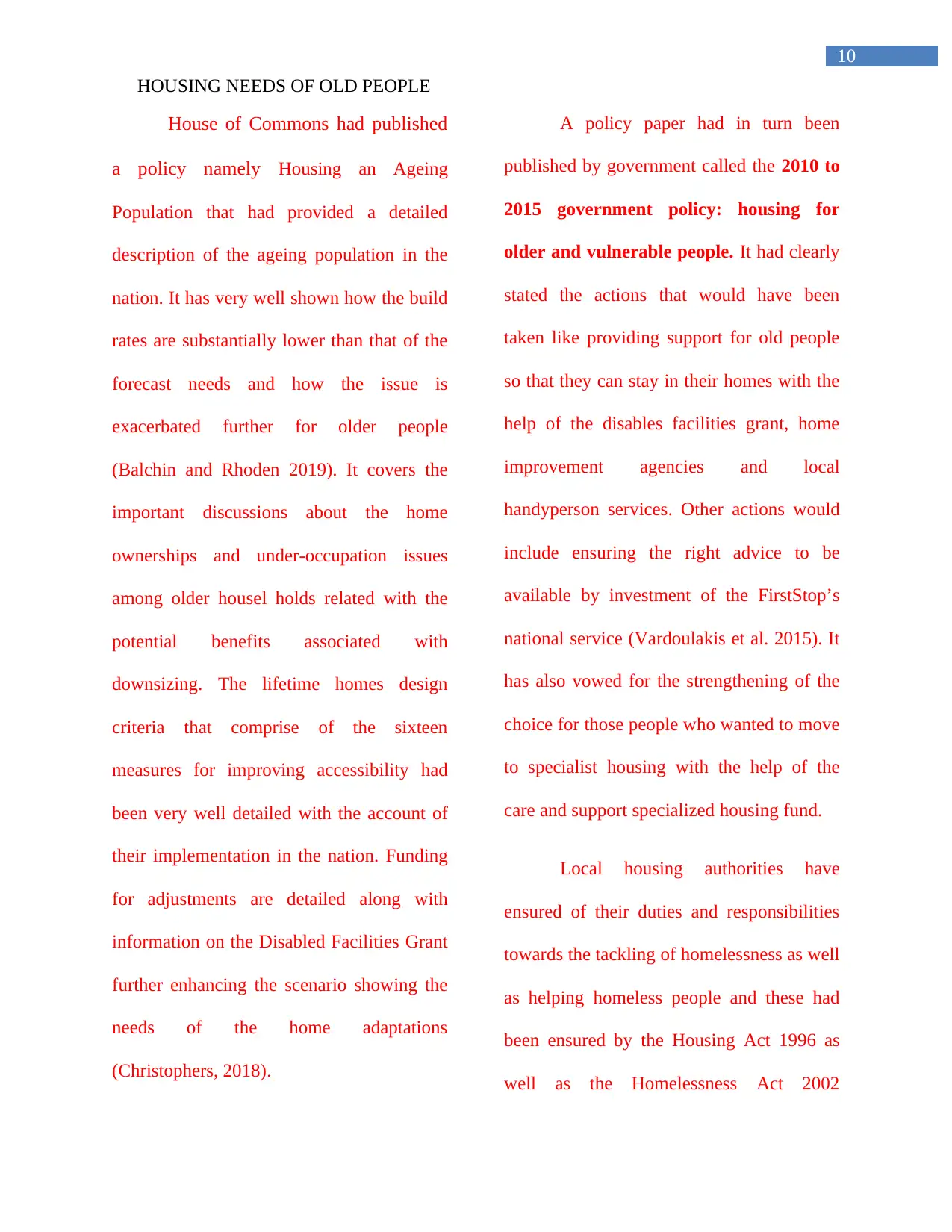
10
HOUSING NEEDS OF OLD PEOPLE
House of Commons had published
a policy namely Housing an Ageing
Population that had provided a detailed
description of the ageing population in the
nation. It has very well shown how the build
rates are substantially lower than that of the
forecast needs and how the issue is
exacerbated further for older people
(Balchin and Rhoden 2019). It covers the
important discussions about the home
ownerships and under-occupation issues
among older housel holds related with the
potential benefits associated with
downsizing. The lifetime homes design
criteria that comprise of the sixteen
measures for improving accessibility had
been very well detailed with the account of
their implementation in the nation. Funding
for adjustments are detailed along with
information on the Disabled Facilities Grant
further enhancing the scenario showing the
needs of the home adaptations
(Christophers, 2018).
A policy paper had in turn been
published by government called the 2010 to
2015 government policy: housing for
older and vulnerable people. It had clearly
stated the actions that would have been
taken like providing support for old people
so that they can stay in their homes with the
help of the disables facilities grant, home
improvement agencies and local
handyperson services. Other actions would
include ensuring the right advice to be
available by investment of the FirstStop’s
national service (Vardoulakis et al. 2015). It
has also vowed for the strengthening of the
choice for those people who wanted to move
to specialist housing with the help of the
care and support specialized housing fund.
Local housing authorities have
ensured of their duties and responsibilities
towards the tackling of homelessness as well
as helping homeless people and these had
been ensured by the Housing Act 1996 as
well as the Homelessness Act 2002
HOUSING NEEDS OF OLD PEOPLE
House of Commons had published
a policy namely Housing an Ageing
Population that had provided a detailed
description of the ageing population in the
nation. It has very well shown how the build
rates are substantially lower than that of the
forecast needs and how the issue is
exacerbated further for older people
(Balchin and Rhoden 2019). It covers the
important discussions about the home
ownerships and under-occupation issues
among older housel holds related with the
potential benefits associated with
downsizing. The lifetime homes design
criteria that comprise of the sixteen
measures for improving accessibility had
been very well detailed with the account of
their implementation in the nation. Funding
for adjustments are detailed along with
information on the Disabled Facilities Grant
further enhancing the scenario showing the
needs of the home adaptations
(Christophers, 2018).
A policy paper had in turn been
published by government called the 2010 to
2015 government policy: housing for
older and vulnerable people. It had clearly
stated the actions that would have been
taken like providing support for old people
so that they can stay in their homes with the
help of the disables facilities grant, home
improvement agencies and local
handyperson services. Other actions would
include ensuring the right advice to be
available by investment of the FirstStop’s
national service (Vardoulakis et al. 2015). It
has also vowed for the strengthening of the
choice for those people who wanted to move
to specialist housing with the help of the
care and support specialized housing fund.
Local housing authorities have
ensured of their duties and responsibilities
towards the tackling of homelessness as well
as helping homeless people and these had
been ensured by the Housing Act 1996 as
well as the Homelessness Act 2002

11
HOUSING NEEDS OF OLD PEOPLE
(Howenstein 2017).The Mobile Homes Act
1983 helps by giving residents the security
of tenure as well as different certain rights
that included a right to sell their homes as
well as their right to quiet enjoyment of their
homes (Nevitt 2016). The government is
founded to be safeguarding the vulnerable
adults as set out in the ‘Statement of
government policy on adult
safeguarding.’ The document is seen to
include a statement of principle for using
any local authority social services and
housing including health, police as well as
other agencies for both developing as well
as assessing the effectiveness of their local
safeguarding arrangements
Modification of environmental barriers:
Studies are of the opinion that
although problems might occur throughout
the homes, research state that
environmental barriers to that of safety and
health of individuals in the home can be
linked to three primary services
(Howenstein 2017). These are getting in
and out of the house, moving around the
house and also performing self care.
Interventions need to be taken care in
these three arenas while developing or
modifying the houses of the individuals.
To develop safety and mobility, walkways
need to have smooth and slip-resistant
surfaces; presence of handrails, widened
doorways, automatic opening system and
many other interventions can be taken.
Hallways and doors should be made wide
so that such people with wheelchairs can
have easy access to bathrooms. To ensure
safety, enough allocation of space should
be provided in the toilet shower, bathtub as
well as sink for the mobility aids and the
caregiver assistance. It can be also found
that safety can be increased by
implementation of the supports like that of
grab bars, safety frame, or floor-to-ceiling
pole, using of contrasting colors and many
HOUSING NEEDS OF OLD PEOPLE
(Howenstein 2017).The Mobile Homes Act
1983 helps by giving residents the security
of tenure as well as different certain rights
that included a right to sell their homes as
well as their right to quiet enjoyment of their
homes (Nevitt 2016). The government is
founded to be safeguarding the vulnerable
adults as set out in the ‘Statement of
government policy on adult
safeguarding.’ The document is seen to
include a statement of principle for using
any local authority social services and
housing including health, police as well as
other agencies for both developing as well
as assessing the effectiveness of their local
safeguarding arrangements
Modification of environmental barriers:
Studies are of the opinion that
although problems might occur throughout
the homes, research state that
environmental barriers to that of safety and
health of individuals in the home can be
linked to three primary services
(Howenstein 2017). These are getting in
and out of the house, moving around the
house and also performing self care.
Interventions need to be taken care in
these three arenas while developing or
modifying the houses of the individuals.
To develop safety and mobility, walkways
need to have smooth and slip-resistant
surfaces; presence of handrails, widened
doorways, automatic opening system and
many other interventions can be taken.
Hallways and doors should be made wide
so that such people with wheelchairs can
have easy access to bathrooms. To ensure
safety, enough allocation of space should
be provided in the toilet shower, bathtub as
well as sink for the mobility aids and the
caregiver assistance. It can be also found
that safety can be increased by
implementation of the supports like that of
grab bars, safety frame, or floor-to-ceiling
pole, using of contrasting colors and many

12
HOUSING NEEDS OF OLD PEOPLE
others (Swenarton 2018). It is extremely
important for the governmental
departments to develop effective policy for
overcoming the different housing issues
that are faced by the older people of the
nation. The policy should be covering four
important areas in their policy
development. These would be the
promotion of the independence of the
older people with enabling them with
accessible and adaptable homes along with
the tackling of the poor conditions and
delivering decent homes. They should be
also integrating housing with the health
and social care and even building for the
future sheltered and retirement housing
Conclusion:
From the above discussion, it
become clear that older people often face
various kinds of issues as they gradually
age like mobility issues, issues with their
activity of daily living, financial
insecurities and many others. It has been
found that the houses where they reside
are often not suitable to ensure safety and
comfortable living to ensure quality living
by the people. However, a number of
factors are seen to affect the housing
conditions of the people like houses are
not designed to meet the needs of older
people, dampen houses, unhygienic places,
houses with high risk of fall and many
others. Hence, important strategies need to
be taken so as to ensure that high quality
housing to older people helping them to
live healthy and satisfactory lives.
Source: (Swenarton 2018)
HOUSING NEEDS OF OLD PEOPLE
others (Swenarton 2018). It is extremely
important for the governmental
departments to develop effective policy for
overcoming the different housing issues
that are faced by the older people of the
nation. The policy should be covering four
important areas in their policy
development. These would be the
promotion of the independence of the
older people with enabling them with
accessible and adaptable homes along with
the tackling of the poor conditions and
delivering decent homes. They should be
also integrating housing with the health
and social care and even building for the
future sheltered and retirement housing
Conclusion:
From the above discussion, it
become clear that older people often face
various kinds of issues as they gradually
age like mobility issues, issues with their
activity of daily living, financial
insecurities and many others. It has been
found that the houses where they reside
are often not suitable to ensure safety and
comfortable living to ensure quality living
by the people. However, a number of
factors are seen to affect the housing
conditions of the people like houses are
not designed to meet the needs of older
people, dampen houses, unhygienic places,
houses with high risk of fall and many
others. Hence, important strategies need to
be taken so as to ensure that high quality
housing to older people helping them to
live healthy and satisfactory lives.
Source: (Swenarton 2018)
Paraphrase This Document
Need a fresh take? Get an instant paraphrase of this document with our AI Paraphraser
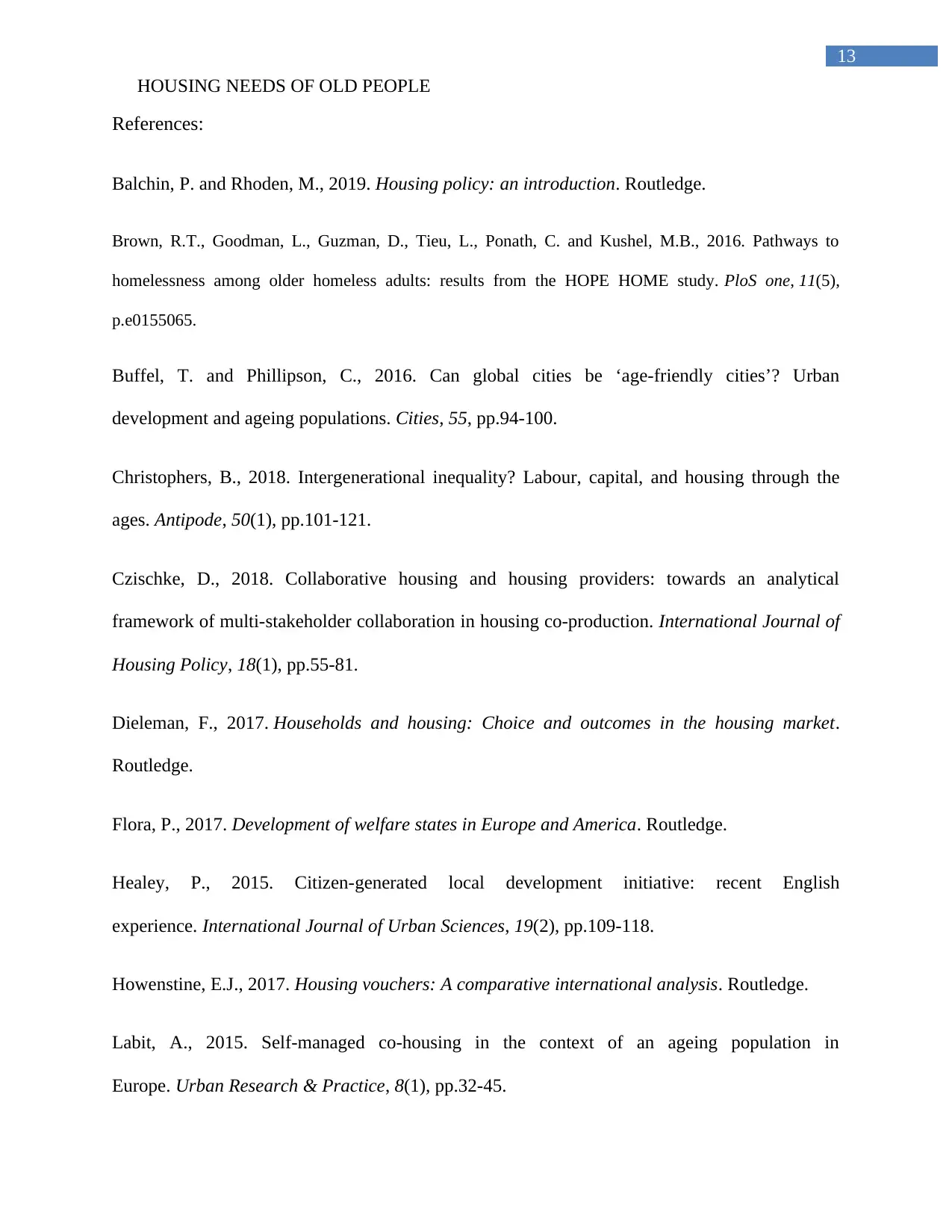
13
HOUSING NEEDS OF OLD PEOPLE
References:
Balchin, P. and Rhoden, M., 2019. Housing policy: an introduction. Routledge.
Brown, R.T., Goodman, L., Guzman, D., Tieu, L., Ponath, C. and Kushel, M.B., 2016. Pathways to
homelessness among older homeless adults: results from the HOPE HOME study. PloS one, 11(5),
p.e0155065.
Buffel, T. and Phillipson, C., 2016. Can global cities be ‘age-friendly cities’? Urban
development and ageing populations. Cities, 55, pp.94-100.
Christophers, B., 2018. Intergenerational inequality? Labour, capital, and housing through the
ages. Antipode, 50(1), pp.101-121.
Czischke, D., 2018. Collaborative housing and housing providers: towards an analytical
framework of multi-stakeholder collaboration in housing co-production. International Journal of
Housing Policy, 18(1), pp.55-81.
Dieleman, F., 2017. Households and housing: Choice and outcomes in the housing market.
Routledge.
Flora, P., 2017. Development of welfare states in Europe and America. Routledge.
Healey, P., 2015. Citizen-generated local development initiative: recent English
experience. International Journal of Urban Sciences, 19(2), pp.109-118.
Howenstine, E.J., 2017. Housing vouchers: A comparative international analysis. Routledge.
Labit, A., 2015. Self-managed co-housing in the context of an ageing population in
Europe. Urban Research & Practice, 8(1), pp.32-45.
HOUSING NEEDS OF OLD PEOPLE
References:
Balchin, P. and Rhoden, M., 2019. Housing policy: an introduction. Routledge.
Brown, R.T., Goodman, L., Guzman, D., Tieu, L., Ponath, C. and Kushel, M.B., 2016. Pathways to
homelessness among older homeless adults: results from the HOPE HOME study. PloS one, 11(5),
p.e0155065.
Buffel, T. and Phillipson, C., 2016. Can global cities be ‘age-friendly cities’? Urban
development and ageing populations. Cities, 55, pp.94-100.
Christophers, B., 2018. Intergenerational inequality? Labour, capital, and housing through the
ages. Antipode, 50(1), pp.101-121.
Czischke, D., 2018. Collaborative housing and housing providers: towards an analytical
framework of multi-stakeholder collaboration in housing co-production. International Journal of
Housing Policy, 18(1), pp.55-81.
Dieleman, F., 2017. Households and housing: Choice and outcomes in the housing market.
Routledge.
Flora, P., 2017. Development of welfare states in Europe and America. Routledge.
Healey, P., 2015. Citizen-generated local development initiative: recent English
experience. International Journal of Urban Sciences, 19(2), pp.109-118.
Howenstine, E.J., 2017. Housing vouchers: A comparative international analysis. Routledge.
Labit, A., 2015. Self-managed co-housing in the context of an ageing population in
Europe. Urban Research & Practice, 8(1), pp.32-45.
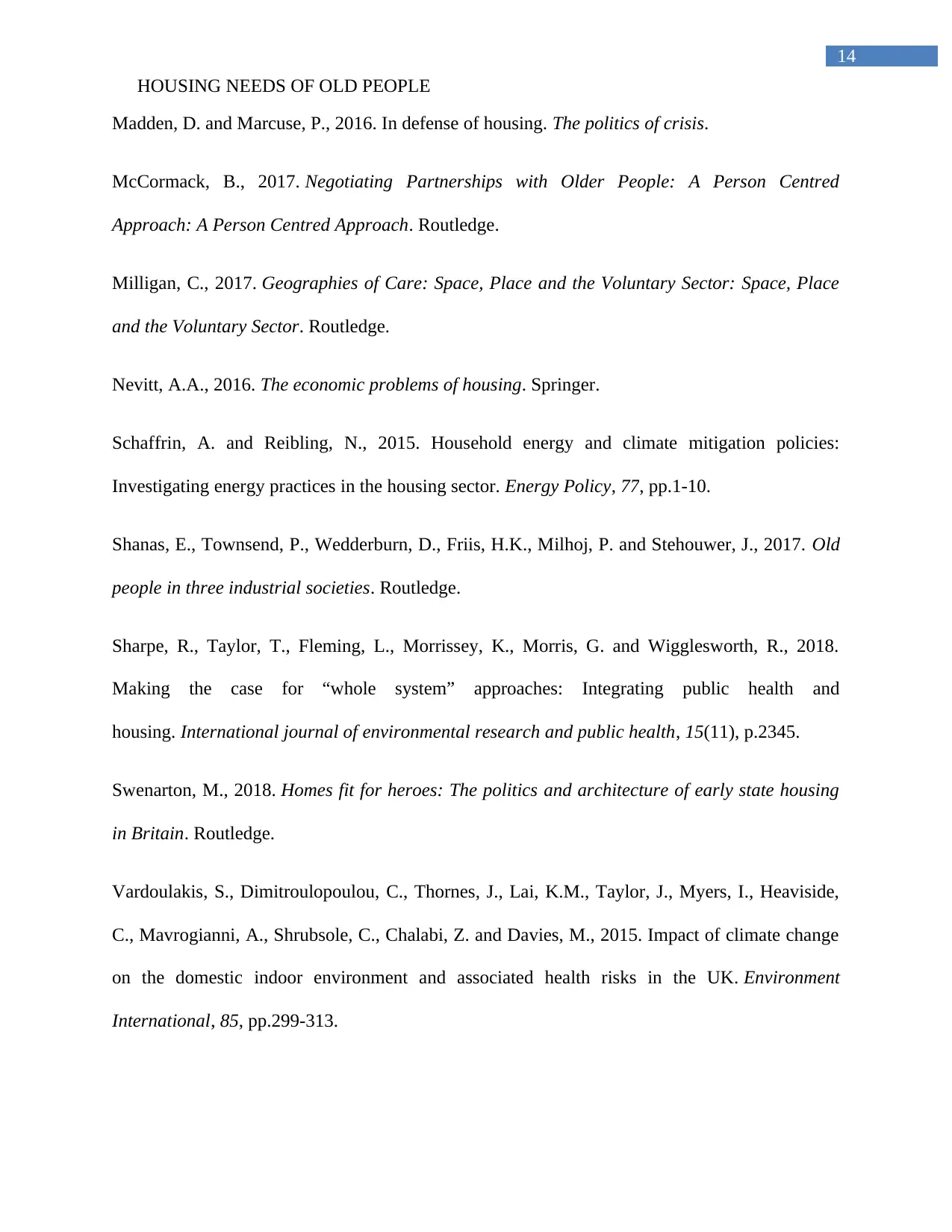
14
HOUSING NEEDS OF OLD PEOPLE
Madden, D. and Marcuse, P., 2016. In defense of housing. The politics of crisis.
McCormack, B., 2017. Negotiating Partnerships with Older People: A Person Centred
Approach: A Person Centred Approach. Routledge.
Milligan, C., 2017. Geographies of Care: Space, Place and the Voluntary Sector: Space, Place
and the Voluntary Sector. Routledge.
Nevitt, A.A., 2016. The economic problems of housing. Springer.
Schaffrin, A. and Reibling, N., 2015. Household energy and climate mitigation policies:
Investigating energy practices in the housing sector. Energy Policy, 77, pp.1-10.
Shanas, E., Townsend, P., Wedderburn, D., Friis, H.K., Milhoj, P. and Stehouwer, J., 2017. Old
people in three industrial societies. Routledge.
Sharpe, R., Taylor, T., Fleming, L., Morrissey, K., Morris, G. and Wigglesworth, R., 2018.
Making the case for “whole system” approaches: Integrating public health and
housing. International journal of environmental research and public health, 15(11), p.2345.
Swenarton, M., 2018. Homes fit for heroes: The politics and architecture of early state housing
in Britain. Routledge.
Vardoulakis, S., Dimitroulopoulou, C., Thornes, J., Lai, K.M., Taylor, J., Myers, I., Heaviside,
C., Mavrogianni, A., Shrubsole, C., Chalabi, Z. and Davies, M., 2015. Impact of climate change
on the domestic indoor environment and associated health risks in the UK. Environment
International, 85, pp.299-313.
HOUSING NEEDS OF OLD PEOPLE
Madden, D. and Marcuse, P., 2016. In defense of housing. The politics of crisis.
McCormack, B., 2017. Negotiating Partnerships with Older People: A Person Centred
Approach: A Person Centred Approach. Routledge.
Milligan, C., 2017. Geographies of Care: Space, Place and the Voluntary Sector: Space, Place
and the Voluntary Sector. Routledge.
Nevitt, A.A., 2016. The economic problems of housing. Springer.
Schaffrin, A. and Reibling, N., 2015. Household energy and climate mitigation policies:
Investigating energy practices in the housing sector. Energy Policy, 77, pp.1-10.
Shanas, E., Townsend, P., Wedderburn, D., Friis, H.K., Milhoj, P. and Stehouwer, J., 2017. Old
people in three industrial societies. Routledge.
Sharpe, R., Taylor, T., Fleming, L., Morrissey, K., Morris, G. and Wigglesworth, R., 2018.
Making the case for “whole system” approaches: Integrating public health and
housing. International journal of environmental research and public health, 15(11), p.2345.
Swenarton, M., 2018. Homes fit for heroes: The politics and architecture of early state housing
in Britain. Routledge.
Vardoulakis, S., Dimitroulopoulou, C., Thornes, J., Lai, K.M., Taylor, J., Myers, I., Heaviside,
C., Mavrogianni, A., Shrubsole, C., Chalabi, Z. and Davies, M., 2015. Impact of climate change
on the domestic indoor environment and associated health risks in the UK. Environment
International, 85, pp.299-313.

15
HOUSING NEEDS OF OLD PEOPLE
Zhou, J. and Walker, A., 2016. The need for community care among older people in
China. Ageing & Society, 36(6), pp.1312-1332.
HOUSING NEEDS OF OLD PEOPLE
Zhou, J. and Walker, A., 2016. The need for community care among older people in
China. Ageing & Society, 36(6), pp.1312-1332.
1 out of 16
Related Documents
Your All-in-One AI-Powered Toolkit for Academic Success.
+13062052269
info@desklib.com
Available 24*7 on WhatsApp / Email
![[object Object]](/_next/static/media/star-bottom.7253800d.svg)
Unlock your academic potential
© 2024 | Zucol Services PVT LTD | All rights reserved.





